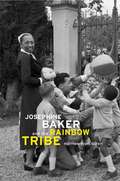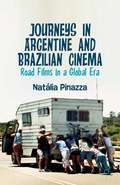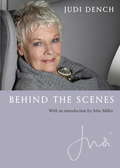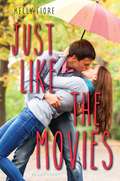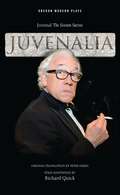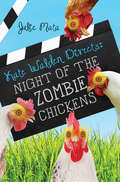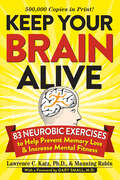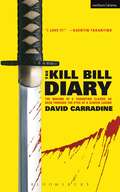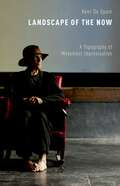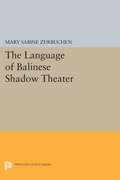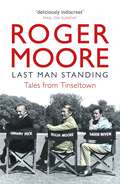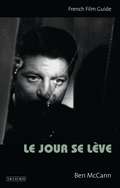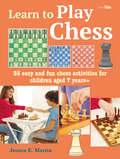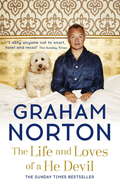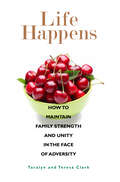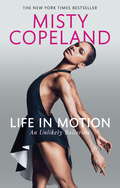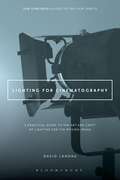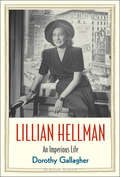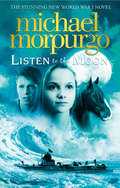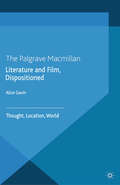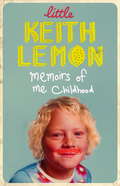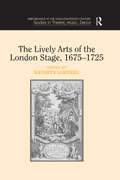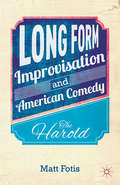- Table View
- List View
Josephine Baker and the Rainbow Tribe
by Matthew Pratt GuterlHer performing days numbered, Josephine Baker did something outrageous: she transformed her chateau into a theme park whose main attraction was her Rainbow Tribe--12 children from around the globe, adopted as the family of the future. Matthew Pratt Guterl concludes that Baker was a serious activist, determined to make a positive difference.
Journeys in Argentine and Brazilian Cinema: Road Films in a Global Era
by N. PinazzaMany South American films that use the popular road movie format to examine regional culture and attitudes, especially in Argentina and Brazil. Pinazza performs a careful cultural analysis of the films and investigates how road movies deal with narratives on nationhood whilst simultaneously inserting themselves in a transnational dialogue.
Judi: With an Introduction by John Miller
by Dame Judi Dench'National treasure? I hate that. Too dusty, too in a cupboard, too behind glass, too staid ... What I love is being part of a company. On stage I am not trying to be myself, I'm trying to be someone else, the more unlike me the better.'From her first theatrical roles as a teenager in York to her scene-stealing performances as 'M' in the James Bond films, Dame Judi Dench's professional life has consisted of non-stop acting, leading to numerous accolades, including an Academy Award.BEHIND THE SCENES is a uniquely personal take on Dame Judi's life and brilliant career, showing her off stage as well as on: in the wings, off sets, in dressing rooms and happily larking about. Beautifully illustrated with photographs from her own collections, here are reflections and reminiscences on those who have mattered to her most - her family, fellow actors, directors and writers - communicated with the truth and insight of her acting.
Just Like the Movies (If Only Ser.)
by Kelly FiorePretty, popular Marijke Monti and over-achieving nerd-girl Lily Spencer have little in common-except that neither feels successful when it comes to love. Marijke can't get her boyfriend to say "I love you†? and Lily can't get a boyfriend at all. When the girls end up at a late night showing of Titanic, sniffling along with the sinking ship, they realize that their love lives could-and should-be better. Which sparks an idea: Why can't life be like a movie? Why can't they create perfect romantic situations? Now they have a budding friendship and a plan-to act out grand gestures and get the guys of their dreams. It seems like fun at first, but reality turns out to be much more complicated, and they didn't take into account that finding true love usually requires finding yourself first.
Juvenalia (Oberon Modern Plays)
by Richard QuickSimon Callow does stand-up comedy. Filthy, foul mouthed, viciously funny and deeply politically incorrect. The target: immigrants, plutocrats, women, gays. As last delivered in Rome AD 100. Juvenal was one angry white middle-class male. In Juvenalia he tells it like it was. And is. The writer, Juvenal born circa AD55, wrote sixteen satires that attacked the decadence of Rome in its heyday. Here, adapted by Richard Quick, we are given a view into the moral decline that is as relevant now, as it was back then.
Kate Walden Directs: Night of the Zombie Chickens (Kate Walden Directs Ser. #1)
by Julie MataNight of the Zombie Chickens is supposed to be Kate Walden's breakout film. But her supporting actresses???her mother's prize organic hens???are high maintenance, to say the least. Thank goodness Kate's best friend Alyssa is the star. She's great at screaming and even better at killing zombies in creative ways. But when Alyssa turns into a real-life soulless zombie and ditches Kate for the most popular girl in seventh grade, Kate suddenly finds herself both friendless and starless. Now, thanks to Alyssa's new crowd, Kate is the butt of every joke at school and consigned to the loser table at lunch. If movies have taught Kate anything, it's that the good guy can always win???with the right script. And her fellow social outcasts may be the key to her own happy ending. Kate hatches the perfect revenge plot against her former best friend, but even though her screenplay is foolproof, Kate soon realizes that nothing???in filmmaking or in life???ever goes exactly as planned. Especially when there are diabolical hens out to get you.
Keep Your Brain Alive: 83 Neurobic Exercises to Help Prevent Memory Loss and Increase Mental Fitness
by Lawrence Katz Manning RubinOver 40? Getting forgetful? Discover the secret of neurobics. Neurobics is a unique brain exercise program that can be done anytime, anywhere. Based on the latest neuroscience, these deceptively simple exercises stimulate brain nutrients to help new brain cells grow. The key to keeping your brain strong and healthy is to break routines and use all five senses in unexpected ways. Offbeat, fun, and easy, these 83 exercises will result in a mind fit to meet any challenge—whether remembering a name, learning a new app, or staying creative in your work.
The Kill Bill Diary: The Making of a Tarantino Classic as Seen Through the Eyes of a Screen Legend (Screen and Cinema)
by David CarradineThe quirky, strange and utterly sagacious meditations of David Caradine written during the making of Quentin Tarantino's contemporary classic in which Carradine played the lead role.When Carradine landed the lead role in Quentin Tarantino's new film, Kill Bill, it catapulted him into the Hollywood limelight. This journal captures his experience of being courted by Tarantino for the role of Bill and the subsequent two years spent making the two-part feature film with co-star Uma Thurman, nominated for a Best Actress Golden Globe. In its mixture of autobiography and behind-the-scenes diary, The Kill Bill Diary takes the reader on a fascinating and witty journey into the world of film-making and the art of an acclaimed director. Along the way Carradine describes the martial arts training required for the role, the experience of filming in China, working with Tarantino and falling in love with Uma Thurman while 'swinging a steel-tempered Samurai sword at her head'.In describing the pre-production, production and promoting of the film, Carradine gives readers a rare and wholly authentic insight into the creation of a Hollywood blockbuster and the experience of a screen legend.
The Kill Bill Diary: The Making of a Tarantino Classic as Seen Through the Eyes of a Screen Legend (Screen and Cinema)
by David CarradineThe quirky, strange and utterly sagacious meditations of David Caradine written during the making of Quentin Tarantino's contemporary classic in which Carradine played the lead role.When Carradine landed the lead role in Quentin Tarantino's new film, Kill Bill, it catapulted him into the Hollywood limelight. This journal captures his experience of being courted by Tarantino for the role of Bill and the subsequent two years spent making the two-part feature film with co-star Uma Thurman, nominated for a Best Actress Golden Globe. In its mixture of autobiography and behind-the-scenes diary, The Kill Bill Diary takes the reader on a fascinating and witty journey into the world of film-making and the art of an acclaimed director. Along the way Carradine describes the martial arts training required for the role, the experience of filming in China, working with Tarantino and falling in love with Uma Thurman while 'swinging a steel-tempered Samurai sword at her head'.In describing the pre-production, production and promoting of the film, Carradine gives readers a rare and wholly authentic insight into the creation of a Hollywood blockbuster and the experience of a screen legend.
Landscape of the Now: A Topography of Movement Improvisation
by Kent De SpainIn Landscape of the Now, author Kent De Spain takes readers on a deep journey into the underlying processes and structures of postmodern movement improvisation. Based on a series of interviews with master teachers who have developed unique approaches that are taught around the world - Steve Paxton, Simone Forti, Lisa Nelson, Deborah Hay, Nancy Stark Smith, Barbara Dilley, Anna Halprin, and Ruth Zaporah - this book offers the rare opportunity to find some clarity in what is often a complex and confusing experience. After more than 20 years of research, De Spain has created an extensive list of questions that explore issues that arise for the improviser in practice and performance as well as resources that influence movements and choices. Answers to these questions are placed side by side to create dialog and depth of understanding, and to see the range of possible approaches experienced improvisers might explore. In its nineteen chapters, Landscape of the Now delves into issues like the influence of an audience on an improviser's choices or how performers "track" and use their experience of the moment. The book also looks at the role of cognitive skills, memory, space, emotion, and the senses. One chapter offers a rare opportunity for an honest discussion of the role of various forms of spirituality in what is seen as a secular dance form. Whether read from cover to cover or pulled apart and explored a subject at a time, Landscape of the Now offers the reader a kind of map into the mysterious realm of human creativity, and the wisdom and experience of artists who have spent a lifetime exploring it.
The Language of Balinese Shadow Theater
by Mary Sabine ZurbuchenBali's shadow puppet theater, like others in Southeast Asia, is a complex tradition with many conventions that puzzle Western observers. Mary Zurbuchen demonstrates how the linguistic codes of this rich art form mediate between social groups, cultural influences, historical periods, and conceptual schemes.Originally published in 1987.The Princeton Legacy Library uses the latest print-on-demand technology to again make available previously out-of-print books from the distinguished backlist of Princeton University Press. These editions preserve the original texts of these important books while presenting them in durable paperback and hardcover editions. The goal of the Princeton Legacy Library is to vastly increase access to the rich scholarly heritage found in the thousands of books published by Princeton University Press since its founding in 1905.
Last Man Standing: Tales from Tinseltown
by Roger MooreIn a career that spans over seven decades, Roger Moore has been at the very heart of the show-business scene. We all know him as an actor who has starred in films that have made him famous the world over, but he's also a tremendous prankster, joker and raconteur - in fact, he's well known as one of the nicest guys in the business, and someone who has always been up for some fun.In this fabulous collection of true stories from his stellar career, Roger lifts the lid on the movie business, from Hollywood to Pinewood. It features outrageous tales from his own life and career as well as those told to him by a host of stars and filmmakers, including Tony Curtis, Sean Connery, Michael Caine, David Niven, Frank Sinatra, Gregory Peck, John Mills, Peter Sellers, Michael Winner, Cubby Broccoli and many more. Wonderfully entertaining and laugh-out-loud fu
Le Jour se Lève: French Film Guide (Ciné-File French Film Guides)
by Ben McCannLe Jour se leve (1939) directed by Marcel Carnè, is widely recognised as the classic French Poetic Realist film. Told in flashback, it recounts the story of a man who has committed a murder, and who awaits his fate as the police close in. Carnè shuttles between different registers, tones and textures throughout, marshalling the studio's resources to create striking pictorial compositions. The film also contains the great French star Jean Gabin's most iconic performance as Francois, marooned at the top of his apartment building. Ben McCann's perceptive and lively book traces the evolution of Le Jour se leve and situates it in a very specific historical moment. He also underlines the importance of actors Jules Berry and Arletty, production designer Alexandre Trauner, writer Jacques Prevert and cinematographer Curt Courant in establishing the film's tone, mood and visual style. He charts the national and international reception of the film, uncovering a work that deeply divided critics at a time of national crisis. He also reveals Le Jour se leve to be a key transitional work between European and American noir and compares it with the 1947 Hollywood remake.Highlighting its combination of the 'poetic' and the 'realist' this book finally stresses how Le Jour se leve represents the very best of pre-war French studio filmmaking.
Learn to Play Chess
by Jessica E Prescott35 easy and fun chess activities for children aged 7 years +
The Life and Loves of a He Devil: A Memoir
by Graham Norton'I defy anyone not to snort, howl and recoil' The Sunday Times'Full of wicked asides, tart observations and sharp remarks that could only have originated in Graham Norton's witty brain.' Terry WoganLooking around the room I saw what life really was. It was made up of my passions. I saw my life reflected back at me. People I liked, people I loved, people I had shared half a century with. All the stories of my life were together in that one room and it made me very happy. Who wouldn't want a friend like Graham Norton? A little bit naughty, full of frank advice, bursting with gossip about the world's biggest stars - but most of all with an emphatic love of life and all its joys, big and small. Join him - glass of wine in hand, faithful doggy friend by your side - and delve in as he shares the loves of his life.
Life Happens: How to Maintain Family Strength and Unity in the Face of Adversity
by Teresa Clark Taralyn ClarkIt happens to every family. Things are humming along smoothly when suddenly they realize that life is not just a bowl of cherries. An unlooked for event, crisis, or trial threatens to upset the balance of all they consider normal. How will they ever survive and how will they ever get things to return to normal? Is it even possible? What if constant change and adaptation is what “normal” really looks like? In Life Happens Taralyn and Teresa Clark explore life realities and provide much-needed information gained from decades of experience to survive and ultimately thrive in spite of life challenges.
Life in Motion: An Unlikely Ballerina
by Misty CopelandWhen Misty Copeland first placed her hands on the ballet barre at an after-school community centre, no one expected the undersized, underprivileged and anxious thirteen-year-old to become one of America's most groundbreaking dancers. A true prodigy, she was attempting in months roles that take most dancers years to master. But when Misty became caught between the control and comfort she found in the world of ballet and the harsh realities of her own life, she had to choose to embrace both her identity and her dreams, and find the courage to be one of a kind.In this instant New York Times bestseller, Misty Copeland tells the story of her historic journey to become the first African-American principal ballerina at the prestigious American Ballet Theatre. With an insider's passion, Misty opens a window into the life of an artist who lives life centre stage, from behind the scenes at her first classes to her triumphant roles in some of the world's most iconic ballets. Life in Motion is a story of passion, identity and grace for anyone who has dared to dream of a different life.
Lighting for Cinematography: A Practical Guide to the Art and Craft of Lighting for the Moving Image (The CineTech Guides to the Film Crafts)
by David LandauWe can't shoot good pictures without good lighting, no matter how good the newest cameras are. Shooting under available light gives exposure, but lacks depth, contrast, contour, atmosphere and often separation. The story could be the greatest in the world, but if the lighting is poor viewers will assume it's amateurish and not take it seriously. Feature films and TV shows, commercials and industrial videos, reality TV and documentaries, even event and wedding videos tell stories. Good lighting can make them look real, while real lighting often makes them look fake.Lighting for Cinematography, the first volume in the new CineTech Guides to the Film Crafts series, is the indispensable guide for film and video lighting. Written by veteran gaffer and cinematographer David Landau, the book helps the reader create lighting that supports the emotional moment of the scene, contributes to the atmosphere of the story and augments an artistic style. Structured to mimic a 14 week semester, the chapters cover such things as lighting for movement, working with windows, night lighting, lighting the three plains of action and non-fiction lighting. Every chapter includes stills, lighting diagrams and key advice from professionals in the field, as well as lighting exercises to help the reader put into practice what was covered.www.lightingforcinematography.com
Lillian Hellman: An Imperious Life (Jewish Lives)
by Dorothy GallagherGlamorous, talented, audacious—Lillian Hellman knew everyone, did everything, had been everywhere. By the age of twenty-nine she had written The Children’s Hour, the first of four hit Broadway plays, and soon she was considered a member of America’s first rank of dramatists, a position she maintained for more than twenty-five years. Apart from her literary accomplishments—eight original plays and three volumes of memoirs—Hellman lived a rich life filled with notable friendships, controversial political activity, travel, and love affairs, most importantly with Dashiell Hammett. But by the time she died, the truth about her life and works had been called into question. Scandals attached to her name, having to do with sex, with money, and with her own veracity. Dorothy Gallagher confronts the conundrum that was Lillian Hellman—a woman with a capacity to inspire outrage as often as admiration. Exploring Hellman’s leftist politics, her Jewish and Southern background, and her famous testimony before the House Un-American Activities Committee, Gallagher also undertakes a new reading of Hellman’s carefully crafted memoirs and plays, in which she is both revealed and hidden. Gallagher sorts through the facts and the myths, arriving at a sharply drawn portrait of a woman who lived large to the end of her remarkable life and never backed down from a fight.
Listen to the Moon: Listen To The Moon, The Amazing Story Of Adolphus Tips, The Elephant In The Garden
by Michael MorpurgoThe stunning novel set during World War One from Michael Morpurgo, the nation’s favourite storyteller and multi-million copy bestseller.
Literature and Film, Dispositioned: Thought, Location, World (Language, Discourse, Society)
by Alice GavinLiterature and Film, Dispositioned looks to twentieth-century literature's encounter with film as a means to thinking about the locations of thought in literature and literature's location in the world. It includes readings of works by James Joyce, Henry James, and Samuel Beckett, whose Film (1965) forms a concluding focus.
Little Keith Lemon: Memoirs of me Childhood
by Keith LemonHave you ever wondered how Keith Lemon went from life as a young nipper in Leeds to being the strawberry blonde star of Celebrity Juice surrounded by bang tidy lasses? In this heart-warming and inspirational memoir, Keith reveals the story of his childhood, lifting the lid on all the experiences of northern youth that have led him to become the international ladies' man and national treasure he is today. In this hilarious memoir, Keith reminisces about his journey from baby to babe-magnet, delving deep into his past and his early years as an unbelievably talented youngster in Leeds (even before he became a professional sex symbol).
The Lively Arts of the London Stage, 1675–1725 (Performance in the Long Eighteenth Century: Studies in Theatre, Music, Dance)
by Kathryn LowerreUnlike collections of essays which focus on a single century or whose authors are drawn from a single discipline, this collection reflects the myriad performance options available to London audiences, offering readers a composite portrait of the music, drama, and dance productions that characterized this rich period. Just as the performing arts were deeply interrelated, the essays presented here, by scholars from a range of fields, engage in dialogue with others in the volume. The opening section examines a famous series of 1701 performances based on the competition between composers to set William Congreve's masque The Judgment of Paris to music. The essays in the central section (the 'mainpiece') showcase performers and productions on the London stage from a variety of perspectives, including English 'tastes' in art and music, the use of dance, the depiction of madness and masculinity in both spoken and musical performances, and genres and modes in the context of contemporary criticism and theatrical practice. A brief afterpiece looks at comic pieces in relation to satire, parody and homage. By bringing together work by scholars of music, dance, and drama, this cross-disciplinary collection illuminates the interconnecting strands that shaped a vibrant theatrical world.
The Lively Arts of the London Stage, 1675–1725 (Performance in the Long Eighteenth Century: Studies in Theatre, Music, Dance)
by Kathryn LowerreUnlike collections of essays which focus on a single century or whose authors are drawn from a single discipline, this collection reflects the myriad performance options available to London audiences, offering readers a composite portrait of the music, drama, and dance productions that characterized this rich period. Just as the performing arts were deeply interrelated, the essays presented here, by scholars from a range of fields, engage in dialogue with others in the volume. The opening section examines a famous series of 1701 performances based on the competition between composers to set William Congreve's masque The Judgment of Paris to music. The essays in the central section (the 'mainpiece') showcase performers and productions on the London stage from a variety of perspectives, including English 'tastes' in art and music, the use of dance, the depiction of madness and masculinity in both spoken and musical performances, and genres and modes in the context of contemporary criticism and theatrical practice. A brief afterpiece looks at comic pieces in relation to satire, parody and homage. By bringing together work by scholars of music, dance, and drama, this cross-disciplinary collection illuminates the interconnecting strands that shaped a vibrant theatrical world.
Long Form Improvisation and American Comedy: The Harold
by M. FotisLong form scenic improv began with the Harold. The comic philosophy of this form started an era of comedy marked by support, trust, and collaboration. This book tells of the Harold, beginning with the development of improv theatre, through the tensions and evolutions that led to its creation at iO, and to its use in contemporary filmmaking.
